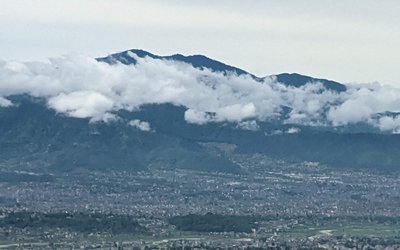It was in 1972, at the initiative of President Ziaur Rahman of Bangladesh and King Birendra of Nepal that SAARC was first mooted, then founded and finally set up in 1985 at Dhaka by Bangladesh President Ershad. The setting up of this association of the poor nations of South East Asia had taken much convincing. Its Secretariat was at Kathmandu with the five identified areas of co-operation being in Agriculture, Rural Development, Telecommunication, Meteorology and lastly Health Population Activities. In the wake of the EEC / EFTA, the hope was that this regional group would develop into a strong entity of free trade and development. There was even talk of having a common currency like the Euro. At the starting of this process there was a feeling that perhaps the big ‘shark might gobble up the small ones.’ A fear then was that India was more enthusiastic to join ASEAN, which was then in the process of being set up too. Over the years, the SAARC foreign ministers gathering has been taking place almost regularly, but the Conference itself has invariably been overshadowed at times and sometimes even postponed, being overshadowed by the relationship between the two big siblings India and Pakistan!
Nepal has held the SAARC Conference on three occasions – in 1987, 2002 and 2014 when Marich Man Singh, Sher Bahadur Deuba and Sushil Koirala were PMs and Head of Government respectively. A major change of attitude perhaps took place in 2002 when Nepal’s then King Gyanendra first voiced that China be considered for membership and that USA and Japan be given observer status. There was even the thought that Nepal would have transport links with both its Northern and Southern neighbours. These ideas were not taken kindly and some feel that this may have been the reason for the displeasure with the Nepali head of state and the subsequent transformation of Nepal into a Federal Republic. Currently however Australia, China, European Union, Iran, Japan, Mauritius, Myanmar, South Korea and USA have observer status. In an ever changing world this is perhaps why the concept of China’s One Belt One Road is having more significance!
The crux of the matter is that there are a lot of shortcomings in the effort to make SAARC a stable organisation. First and foremost may be the reason that almost all the countries in this group have only
lately shaken off their colonial yokes and are in the process of stabilising. Nepal itself is in a state of permanent flux. The latest member of the entity – Afghanistan, which joined in 2007 is in reality a war torn country trying to stabilise. Still there is the thought that Myanmar may still be interested in becoming a member.
The countries of this SAARC Club have only had limited success in bilateral relationships. Twelve Regional SAARC Centres have come up – two each in Bangladesh, Bhutan, India, Nepal, Pakistan and one each in Maldives and Sri Lanka. All these are just functioning in their respective countries as much is not heard about their regional involvement. The idea of a Free Trade Bloc was mooted by Ziaur Rahman as long ago as 1970. The South Asian Free Trade Area was launched only in 2006 with the aim of bringing down of tariffs and trade barriers amongst the now eight countries in the region. It has taken a long time to take off and is not really effective. Even the sharing and broadcasting of meteorological information is hardly taking place. Perhaps Aljazeera, BBC and CNN are providing a better service for all the countries in the world!
During the last SAARC Conference at Kathmandu, when Sushil Koirala was PM, there was some chilliness in the air. Fortunately this disappeared in the warm sunshine of a kausi of the Tourist Lodge when Narendra Modi and Nawab Sharif greeted each other. Right now the atmosphere has evaporated and relationships between the two countries are almost at rock bottom.
In the wake of the recent happenings at Kashmir, the biggest fiasco has been the symbolic attendance of India’s Home Minister Rajnath Singh at the conference of Home Ministers in Islamabad at Pakistan. Media in India stated that the speech he gave was not even reported in the local papers and he just returned back to India after voicing his thoughts! The 19th SAARC Conference is due to be held in Pakistan on 9 and 10th November 2016 but with the present state of affairs, one is prone to think that it will end up by being just one more gathering of heads of State, without any achievement for the people of the region. Will the meeting of Modi and Sharif be able to salvage anything?
What is likely to succeed now is the repackaging of the Old Silk Road that China appears to be intent on reviving. Its new form OBOR or One Belt One Road aims to connect about 60 countries of Asia, Africa and Europe so that trade flourishes and the status of the people improves. Will it be a reality?
A similar example of sorts in this country is the attempt to connect different parts of Nepal, especially all the district headquarters. This has opened the hinterland, made the movement of goods much easier and benefitted many. The only sad part is that many of these new roads are substandard and with the plying of old, overloaded and decrepit buses resulting in a lot of accidents, Deaths and grievous body injuries are daily facts of life. The silver lining in the horizon is the World Bank approval of 55 million dollars for the Road Sector Development Program in Nepal. Let us hope that it is utilised for the Nepali citizen's benefit.
The author writes fiction under the name of Mani Dixit. Website: www.hdixit.org.np. Twitter: @manidixithd

Hemang Dixit
The author writes fiction under the name of Mani Dixit. Website: www.hdixit.org.np. Twitter: @manidixithd
- Top Heavy
- Sep 20, 2023
- Most Able?
- Sep 04, 2023
- Changing Times
- Aug 21, 2023
- Nepali Shenanigans
- Aug 03, 2023
- Budget Naataks
- Jun 29, 2023














